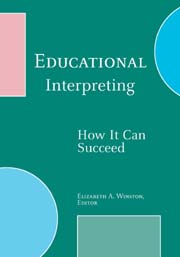How It Can Succeed
Elizabeth A. Winston, Editor
|
View the table of contents. View the list of contributors. Read an excerpt. Read reviews: The Midwest Book Review, The Sign Language Translator and Interpreter. |
$80.00s print edition $80.00 e-book |
This text has been replaced by Advances in Educational Interpreting.
From The Sign Language Translator and Interpreter, cont’d.
The final, particularly revealing, chapter in this part is provided by Elizabeth Winston. She shines the spotlight on a different aspect of the context for educational interpreting, undertaking an innovative research study of the potential ‘visual accessibility’ of mainstream classes of hearing students. The footage analyzed by Winston was collected by the US Department of Education in 1993 for the purposes of showing the range of authentic educational contexts a deaf student may enter if accessing an education in the mainstream through an interpreter. Winston’s analysis reveals that factors affecting the ‘interpretability’ of a class and the level of potential access for a deaf student to the classroom include the pedagogical approach of the teacher in each classroom and the discourse type used for teaching the lesson content. Winston identifies classroom pace, teaching and learning activities, as well as the use of sequential visual prompts as impacting on the potential accessibility of the classroom for a deaf student. She observes that no class in the study, if interpreted, would have provided adequate access for a deaf student, although some may have been more amenable to adaptation to suit a deaf student than others.
Part three, Improving interpreted education, is the shortest section of the volume. Melanie Metzger and Earl Fleetwood’s contribution, although concise, makes several salient points. The field of educational interpreting is sadly lacking in research, and the little that is available suggests that an interpreted education is “at best, restrictive” (p. 171). Metzger and Fleetwood argue a need to establish standards of practice for the field, and, in doing so, they stipulate a series of steps for a proper job analysis and identification of standards required for competent performance.
The next chapter by Marty M. Taylor builds on this premise. She advocates the identification of the interpreting needs of a student assessing the interpreter’s skills, knowledge and abilities before placement; ongoing assessment in the workplace to maintain standards; and appropriate supervision of educational interpreters. Taylor emphasizes the need for interpreters to have a written professional development plan and for regular external evaluation of educational interpreters’ skills in order to maintain interpreter quality.
Brenda Schick and Kevin T. Williams offer a valuable contribution to the volume, unpacking their widely used Educational Interpreter Performance Assessment (EIPA) tool for the reader. The tool is specifically designed to assess the skills of an educational interpreter, with the structure and format of the assessment items and the rating scale geared towards specific skill sets expected. The EIPA is used widely in North America to assess educational interpreters, with minimum scores on the EIPA required for state licensure in some states and provinces of the US and Canada. Schick and Williams indicate that many interpreters assessed do not meet minimum performance standards.
A strong final chapter by Claire Ramsey rounds out the volume. Ramsey expresses concern that the shift towards mainstream schooling for deaf children and placements with educational interpreters is an exercise in providing ‘opportunity’ for inclusion, rather than a strategy that will foster genuine learning for deaf children. She notes that “sometimes, having an interpreter is worse than providing no access at all” (p. 207) because it creates the illusion for educators, administrators and parents that adequate compensation is achieved where it is not. Ramsey elucidates some of the literature on sociolinguistics and cultural-historical psychology and their application to educational interpreting. She also describes the influence of perspectives and assumptions about deaf education on the issue of educational interpreting, the performance expectations of deaf students and their language development. Ramsey claims that even the most competent and skilled educational interpreters cannot hope to provide genuinely effective learning opportunities for deaf students due to the many other factors that will influence a student’s development and academic achievement in the classroom environment.
Elizabeth A. Winston is the director of the Teaching Interpreting Educators and Mentors (TIEM) Center in Loveland, CO, where she directs research into interpreter education practices, discourse analysis, assessment, and evaluation.
Print Edition: ISBN 978-1-56368-309-1, 7 x 10 casebound, 240 pages, 13 tables, 8 figures
$80.00s
E-Book: ISBN 978-1-56368-281-0
$80.00
